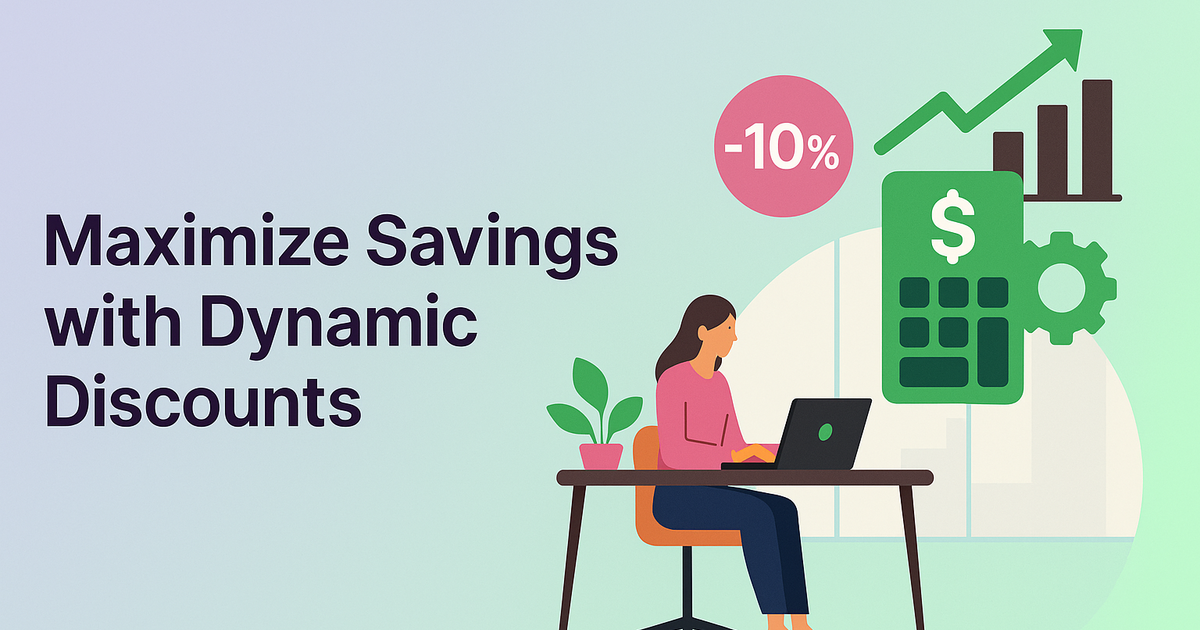What Is Dynamic Discounting?
Dynamic discounting is an automated supplier payment incentive that lets buyers exchange faster payments for flexible discounts that “slide” with the payment date. Unlike a fixed 2/10 net 30 term, the discount percentage changes daily on a pre-agreed curve. Both parties choose the exact trade-off—cash today for the supplier, cost savings for the buyer—each time an invoice is approved.
Think of it as an always-on marketplace embedded in your P2P cycle. When Accounts Payable (AP) clears an invoice on Day 3, you might capture a 2% discount by paying on Day 5. Wait until Day 15, and the discount may fall to 0.8%. Because the rate is dynamic, every invoice becomes its own micro-negotiation, automatically settled by the platform.
Why It Matters Now: Working Capital Basics
Economic uncertainty, rising interest rates, and supply chain risk have elevated working capital to C-suite priority #1. Cash trapped in payables is cheap financing for buyers, but suppliers—especially SMEs—pay double-digit rates to cover day-to-day operations. Dynamic discounting unlocks a middle ground:
- Buyers earn risk-free returns, often 2-4x higher than market deposit rates, while still preserving DPO targets.
- Suppliers reduce borrowing costs and stabilize cash flow, strengthening the network and lowering supply risk.
- Finance gains real-time visibility into payable obligations, a prerequisite for accurate cash forecasting.
Pro Tip: A 1.5% discount captured 20 days early is equivalent to an annualized return of ~27%. Few treasury products can match that without added risk.
How Dynamic Discounting Works—End-to-End
- Invoice Capture & Three-Way Match
Approved invoices flow from your ERP or Procure-to-Pay system into Procbay. No discount can be offered until the invoice is “clean”—matched to a PO and receipt. - Offer Generation
Based on pre-configured Accounts Payable (AP) discount strategies (rate curve, supplier tier, cash-on-hand), the platform calculates a daily discount schedule and presents it to the supplier on the portal. - Supplier Acceptance
Suppliers click “Accept” for immediate payment, counter-offer a different date, or decline. Decisions take seconds because the math is transparent. - Funding & Payment Execution
Buyers fund the payment from on-hand cash or via a short-term credit line. Procbay pushes the payment file to your bank and updates the ERP in real time. - Settlement & Audit Trail
Discount savings post automatically to the general ledger. CFOs get an audit-ready trail showing who offered what, when, and why—critical for SOX compliance.
Supplier Payment Incentives: Win-Win Economics
Early-payment programs often fail when buyers set terms on their own. Dynamic discounting keeps suppliers in control, which drives adoption rates above 60% (the industry average is <25% for static 2/10 programs).
- Cash Flow Predictability: Suppliers can select the precise payment date that aligns with their specific needs, such as covering payroll or purchasing raw materials.
- Lower Financing Costs: A 1% discount for 20 days is often a more attractive option than paying for expensive 12% APR bank lines.
- Relationship Equity: Offering this flexibility signals a collaborative partnership rather than a one-sided demand.
Watch Out: Overly aggressive discount curves can backfire, discouraging participation. Benchmark against the supplier cost of capital before finalizing rates.
Quantifiable Benefits
Let’s ground this discussion with some numbers, based on the average results our Procbay clients see.
| Metric | No Discount Program | Static 2/10 | Dynamic Discounting |
| Discount Capture Rate | 8% of the spend | 18% | 55% |
| Annual Cost Savings | $0 | $360K per $20M spend | $1.1M per $20M spend |
| Avg. Supplier DSO Reduction | 0 days | 10 days | 17 days |
| Buyer Internal Rate of Return | 0% | 18% | 28% |
| Implementation Time | n/a | 4-6 months manual | 6-8 weeks automated |
The delta is dramatic: a shift from static to dynamic incentives can generate over $700K in additional savings on the same spend base, while suppliers accelerate their cash flow nearly twice as fast.
Risks & Mitigation Tactics
No financial strategy is without risk. Here are some common concerns and how modern platforms neutralize them.
- Liquidity Strain: Offering early payments to every supplier seems expensive. To prevent this, platforms like Procbay use cash-availability rules to throttle offers when balances drop below a set target.
- Tier-One Supplier Pushback: Some large vendors prefer supply-chain financing. Hybrid programs allow them to opt out without derailing overall participation.
- Regulatory & Audit Complexity: We ensure compliance with regulations like SOX, GDPR, and local e-invoicing laws through SOC 1-type audit logs, segregation of duties, and automated approvals.
Implementation Playbook: 30-Day Quick Start
- Build the Business Case
Pull the last 12 months of AP data and use Procbay’s ROI calculator to model discount potential. Then, secure treasury alignment on your target yield. - Segment Suppliers
Classify suppliers by their spend, criticality, and willingness to offer a discount. Prioritize mid-tier vendors who typically value cash more than margin. - Configure Discount Curves
Set rate floors and ceilings based on the cost of capital for working capital. Typical curves might start at 2% on Day 5 and taper down to 0.25% by Day 25. - Integrate ERP & Bank
Procbay’s APIs connect with SAP, Oracle, or MS Dynamics. ACH/wire payment files route through your existing banking infrastructure—no new bank accounts are needed. - Pilot & Iterate
Launch the program with a small group of 20 vendors. Track key performance indicators (KPIs) weekly, such as offer acceptance, days-early payments, and cash deployed. Use this data to refine the discount curves before a full rollout.
Case Snapshot: Mid-Market Manufacturer
| KPI | Pre-Implementation | 6 Months After |
| Annual AP Spend | $180M | $180M |
| Early-Payment Discounts Captured | $250K | $2.4M |
| Avg. Invoice Approval Time | 12 days | 2 days |
| Supplier Participation | 11% | 67% |
| Cash Deployed for Discounts | $0 | $15M (rotating) |
| Buyer IRR | n/a | 26% |
The CFO initially feared a liquidity drain. However, by deploying only 8% of the company’s on-hand surplus cash, the team unlocked 10 times more savings. At the same time, suppliers shaved 15 days off their DSO. This proves that incentives, not pressure, are what truly move the needle.
Best Practices for AP Discount Strategies
Now that the fundamentals are covered, here are some field-tested approaches to refine your execution.
- Align With Treasury: Your discount curves should mirror your short-term investment policy. Don’t chase discounts if paying down debt yields higher returns.
- Automate Eligibility Rules: Only route fully matched invoices for discount offers. Nothing erodes trust faster than offering to pay a disputed invoice early.
- Monitor Daily KPIs: Track “discounts missed due to delay” to quickly identify bottlenecks in your intake-to-pay workflow.
- Communicate Value to Suppliers: Provide suppliers with ROI calculators that show how much borrowing cost they save per accepted offer. This can boost adoption by 10-15%.
- Review Curves Quarterly: Interest rates, FX spreads, and commodity cycles change, and your incentive structure should too.
Conclusion: Move From Theory to Savings
Manual early-payment programs leak value because they rely on spreadsheets, one-size-fits-all terms, and end-of-month heroics. Dynamic discounting, executed through an automated, compliant platform, delivers predictable savings, happier suppliers, and working-capital agility that shows up on the income statement.
If you’re ready to see exactly how much hidden cash is on your AP ledger, schedule a 20-minute Procbay demo or run your numbers with our free dynamic-discount ROI calculator. You already approve invoices—now make every approval an opportunity to save.
FAQ: Rapid Answers for Busy Executives
How is dynamic discounting different from supply-chain finance?
Dynamic discounting is buyer-funded; you pay early from your own cash. Supply-chain finance relies on a third-party bank that pays the supplier and collects later from you—great for extending DPO but carries fees and complexity.
What types of suppliers participate most often?
Mid-sized vendors in materials, logistics, and professional services—entities with thin credit lines but solid margins—accept discounts at rates above 50%.
Will offering early payments hurt our cash position?
Not if governed correctly. Procbay uses configurable cash thresholds and forecast integration, so it pauses automatically when liquidity is tight.
How fast can we go live?
Clients integrated with SAP and Oracle typically pilot in 30 days and reach full deployment by Day 60, thanks to Procbay’s pre-built connectors.



